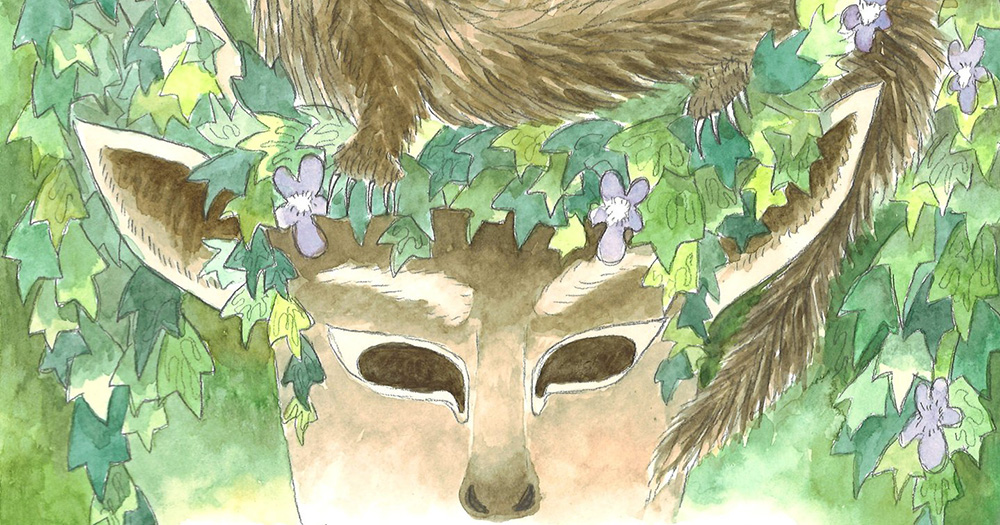The first time I came across the work of Clare Foley was her adaptation of Honoré de Balzac’s short story, La Grande Bretèche, which was part of his masterpiece novel series, La Comédie humaine. I was struck by the beauty of her watercolours and pencils and her wonderful use of colour. Now she is back with another literary adaptation, Forbidden Altars, which adapts two short stories by British author Hector Hugh Munro, better known by the pen name Saki.
Saki was homosexual but began his career in the era of the Cleveland Street scandal (1889) and the downfall of a writer who inspired his work, Oscar Wilde (1895), so that aspect of his life was kept secret. Saki was considered by many scholars to be a master of short stories and Clare has adapted two of these in her new comic.
She said explained: “Adaptation of old work gives you free rein to write about whatever you like, and run with whatever oblique references exist in the text which you’d like to develop, and view it with a whole new lens.”
For Forbidden Altars, she gender-flipped some of the characters and their roles, in part to combat Saki’s misogyny. Clare Foley said of his work: “I find myself a little torn: Saki’s strange propensity towards misogyny in his work alienates me, such as a pervasive mockery of women’s suffrage. But as a queer woman I appreciate his itch to escape from the all-to-familiar repressive heteronormative life, and his wild imagery of the untamable nature of desire rings true.”
The first story she adapted was Sredni Vashtar. It was originally published in 1911 in a short story collection, The Chronicles of Clovis.
It tells the story of Conradin, a sickly 10-year-old boy, who lives in the care of his hated and domineering cousin Mrs De Ropp. He uses his vivid imagination to help him escape from the real world.
Clare switched it to a young girl and a domineering, joyless uncle. She also switched the gender of the ferret god ‘Sredni Vashtar’.
I love how Clare mostly used greys and blacks in her watercolours as I felt it helped express the bleak situation the girl was in. Colour was mainly saved for the girl’s dreams of escape and the fur of the ferret god. It is a bizarre story reminiscent of Roald Dahl, something Clare has noted about Saki’s works.
Coming soon for launch at @comicinvasionb ! ‘Forbidden Altars’, a selection of Saki’s beast stories, adapted as gender-flipped comics 🌿🦌 explore Saki’s strange imaginative worlds with a new feminist and sometimes sapphic lens… pic.twitter.com/AfeuSKMYzM
— Clare Foley (@clarefoleyart) April 29, 2024
The second adaptation, Music On The Hill, which was taken from the same short story collection, is equally dark.
The protagonist is Sylvia Seltoun, an archetypal middle-class woman who, having recently married, has moved to the countryside with Mortimer, her spouse. She is portrayed as a domineering woman who has convinced a man with an “unaffected indifference to women” to marry her.
Once again, Clare has subverted the narrative with a flip in roles. In Clare’s version, a woman, unable to be herself in the society of the time, is pressured into marriage by a dull and ignorant man.
Clare said of this creative choice, “I felt the original story presented such a flat image of womanhood, as a stand-in for the suffocating weight of gender roles and societal expectations. Although I respect Saki as the origin for this tale, the themes in this story, set in a time when women had very little in terms of societal respect or rights, fit more if the protagonist is a man attempting to control his wife.”
Clare also changed the ending from the original story, which saw the woman gored by a bull. This was an odd creative choice by Saki, particularly in a dark comedy, as his mother had died as the result of being charged by a cow.
Once more Clare’s watercolours delight as she depicts the lush greens of the countryside with wonderous purples for the supernatural elements.
I admire Clare’s ability to adapt older works, and this comic is an interesting look at the role of gender in stories when comparing it to the original material. She has removed the misogynistic stereotypes of the domineering older female relative and controlling wife and created new feminist narratives. She also manages to retain the otherworldly feel and queer narratives.
I always recommend Clare’s work but I think this comic is my favourite so far as it also spotlights the work of a queer creator I was unaware of. Check out Clare Foley’s website to pick up a copy and take a look at her other work.
© 2024 GCN (Gay Community News). All rights reserved.
Support GCN
GCN is a free, vital resource for Ireland’s LGBTQ+ community since 1988.
GCN is a trading name of National LGBT Federation CLG, a registered charity - Charity Number: 20034580.
GCN relies on the generous support of the community and allies to sustain the crucial work that we do. Producing GCN is costly, and, in an industry which has been hugely impacted by rising costs, we need your support to help sustain and grow this vital resource.
Supporting GCN for as little as €1.99 per month will help us continue our work as Ireland’s free, independent LGBTQ+ media.

comments. Please sign in to comment.